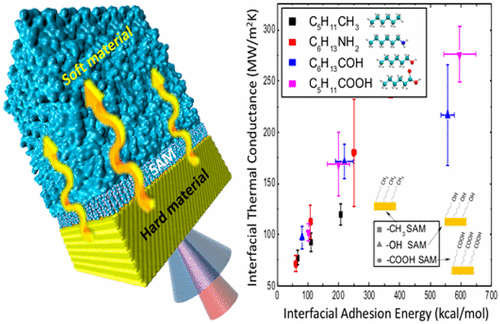当前位置:
X-MOL 学术
›
ACS Energy Lett.
›
论文详情
Our official English website, www.x-mol.net, welcomes your
feedback! (Note: you will need to create a separate account there.)
Thermal Energy Transport across Hard–Soft Interfaces
ACS Energy Letters ( IF 19.3 ) Pub Date : 2017-09-12 00:00:00 , DOI: 10.1021/acsenergylett.7b00570 Xingfei Wei 1 , Teng Zhang 1 , Tengfei Luo 1, 2
ACS Energy Letters ( IF 19.3 ) Pub Date : 2017-09-12 00:00:00 , DOI: 10.1021/acsenergylett.7b00570 Xingfei Wei 1 , Teng Zhang 1 , Tengfei Luo 1, 2
Affiliation

|
Interfacial thermal transport across hard–soft interfaces is of critical importance to a wide variety of energy applications, ranging from composite materials, batteries, thermoelectrics, and photonic crystals to solar–thermal phase transition. In this Perspective, we discuss major experimental and simulation tools used to study such interfacial thermal transport and summarize some new understanding attained. Most studies focus on the interfacial bonding effect, and the underlying relation between bond strength and thermal transport was recently understood from the molecular level: stronger bonds attract soft molecules closer to the hard surface, which leads to more efficient energy communication across the interface. Recent studies have also demonstrated that vibrational spectral coupling is another important factor that influences thermal transport across hard–soft interfaces, a factor that has long been underappreciated for such interfaces. Despite the progress in this field, more research is needed to more deeply understand the physics and transfer the fundamental understanding into rational material design strategies.
中文翻译:

跨软硬接口的热能传输
从复合材料,电池,热电和光子晶体到太阳热相转变,跨软-软界面的界面热传输对于各种能源应用都至关重要。在本《观点》中,我们讨论了用于研究此类界面热传输的主要实验和模拟工具,并总结了一些新的认识。大多数研究都集中在界面键合效应上,而键合强度与热传递之间的潜在关系最近从分子水平上得以理解:更强的键合将软分子吸引到更靠近硬表面的表面,从而使界面上的能量传递更加有效。最近的研究还表明,振动光谱耦合是另一个影响跨软-软界面传热的重要因素,而对于这种界面,这一因素早已被人们所忽视。尽管在该领域取得了进步,但仍需要进行更多的研究以更深入地了解物理学并将基本知识转化为合理的材料设计策略。
更新日期:2017-09-12
中文翻译:

跨软硬接口的热能传输
从复合材料,电池,热电和光子晶体到太阳热相转变,跨软-软界面的界面热传输对于各种能源应用都至关重要。在本《观点》中,我们讨论了用于研究此类界面热传输的主要实验和模拟工具,并总结了一些新的认识。大多数研究都集中在界面键合效应上,而键合强度与热传递之间的潜在关系最近从分子水平上得以理解:更强的键合将软分子吸引到更靠近硬表面的表面,从而使界面上的能量传递更加有效。最近的研究还表明,振动光谱耦合是另一个影响跨软-软界面传热的重要因素,而对于这种界面,这一因素早已被人们所忽视。尽管在该领域取得了进步,但仍需要进行更多的研究以更深入地了解物理学并将基本知识转化为合理的材料设计策略。











































 京公网安备 11010802027423号
京公网安备 11010802027423号